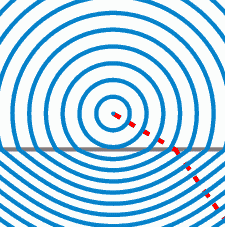Wikipedia:Featured picture candidates/Snells law wavefronts
Snells Law Wavefronts[edit]

- Reason
- This file is not only public domain; it's also open (MATLAB) source. It's at least as elegant and informative as a prior winner: Pi-unrolled-720.gif. It's also made by a Wikipedian with many contributions to the commons.
- Articles this image appears in
- Snell's law, Index of Refraction
- Creator
- Oleg Alexandrov
- Support as nominator --Clarknova (talk) 06:51, 1 January 2009 (UTC)
- Support Simple yet informative.--HereToHelp (talk to me) 17:41, 2 January 2009 (UTC)
- Support Is there a way to turn it off? DurovaCharge! 19:31, 2 January 2009 (UTC)
- Hit 'Esc'. Oleg Alexandrov (talk) 23:45, 2 January 2009 (UTC)
- Support but I don't see why the caption need be restricted to refractive indicies and light since Snell's law can be applied to other waves too. Noodle snacks (talk) 11:43, 3 January 2009 (UTC)
- That's the most used case, and there is no need to be fully general. As long as the reader is given a simple and clear explanation, that should be good enough even if it is not the most all-encompassing. Oleg Alexandrov (talk) 15:57, 3 January 2009 (UTC)
- Actually I agree with Noodle Snacks. When I first read the caption, "speed of light" irked me because it makes the image sound like it is only applicable to light waves. This could leave some lay readers to think it doesn't affect any other type of wave, including every other type of radiation wave. I would suggest a minor rewrite:
Wavefronts from a point source in the context of Snell's law. The region below the gray line has a higher index of refraction and proportionally lower wave velocity than the region above it. (Previously used commas unnecessary)
I feel as if the red dotted line should also be mentioned in the caption, but I don't know how to incorporate it. I also added the image to index of refraction, where it now sits nicely as the main image of the page. I will support this image if the caption can be updated and generalized. ~ ωαdεstεr16«talkstalk» 18:39, 3 January 2009 (UTC)- You still have to be careful as the refractive index is only applicable to the light case. I'd reword the caption for Snell's law to generalise it by omitting the refractive index, or moving to the end a "In the case of light...". Either of the current proposed captions would work fine as is in Refractive Index. Noodle snacks (talk) 23:36, 3 January 2009 (UTC)
- Index of refraction clearly states that it is applicable to sound waves as well. Snell's Law states it is applicable to "light or other waves". Granted both articles are poorly referenced, but if I remember correctly from college physics, Snell's Law and index of refraction are not limited to light. And if it is (and proven), using the term light is a bit loaded and should be replaced with electromagnetic radiation since I also don't remember a limitation set to the visible spectrum. ~ ωαdεstεr16«talkstalk» 06:46, 4 January 2009 (UTC)
- Quite right, I do apologise as I am somewhat ill. Noodle snacks (talk) 07:02, 4 January 2009 (UTC)
- Snell's law is applicible to just about any type of wave who's velocity is dependent on the medium the wave travels through. As to the inclusion of the red line in the caption, I propose this as caption:
Wavefronts from a point source in the context of Snell's law. The region below the gray line has a higher index of refraction and proportionally lower wave velocity than the region above it. The dotted red line is perpendicular to the wavefronts and thus represents a Fermat-shortest path from the source to a point in the lower medium.
If it is somehow possible to incorporate the fact that the wavefronts in the lower medium are hyperbolic rather than spherical, I'm all for it. Fransw (talk) 21:24, 6 January 2009 (UTC)
- Snell's law is applicible to just about any type of wave who's velocity is dependent on the medium the wave travels through. As to the inclusion of the red line in the caption, I propose this as caption:
- Quite right, I do apologise as I am somewhat ill. Noodle snacks (talk) 07:02, 4 January 2009 (UTC)
- Index of refraction clearly states that it is applicable to sound waves as well. Snell's Law states it is applicable to "light or other waves". Granted both articles are poorly referenced, but if I remember correctly from college physics, Snell's Law and index of refraction are not limited to light. And if it is (and proven), using the term light is a bit loaded and should be replaced with electromagnetic radiation since I also don't remember a limitation set to the visible spectrum. ~ ωαdεstεr16«talkstalk» 06:46, 4 January 2009 (UTC)
- You still have to be careful as the refractive index is only applicable to the light case. I'd reword the caption for Snell's law to generalise it by omitting the refractive index, or moving to the end a "In the case of light...". Either of the current proposed captions would work fine as is in Refractive Index. Noodle snacks (talk) 23:36, 3 January 2009 (UTC)
- Actually I agree with Noodle Snacks. When I first read the caption, "speed of light" irked me because it makes the image sound like it is only applicable to light waves. This could leave some lay readers to think it doesn't affect any other type of wave, including every other type of radiation wave. I would suggest a minor rewrite:
- That's the most used case, and there is no need to be fully general. As long as the reader is given a simple and clear explanation, that should be good enough even if it is not the most all-encompassing. Oleg Alexandrov (talk) 15:57, 3 January 2009 (UTC)
Promoted File:Snells_law_wavefronts.gif --Wronkiew (talk) 05:07, 10 January 2009 (UTC)
